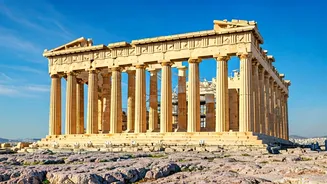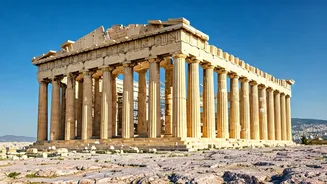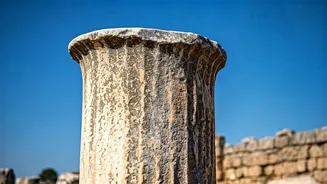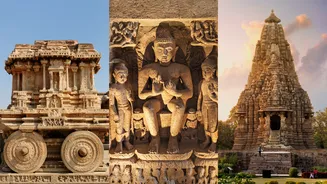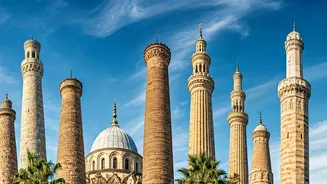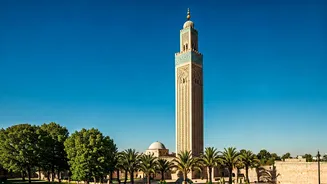Acropolis of Athens
The Acropolis of Athens, a UNESCO World Heritage site, stands as a symbol of classical Greece. Perched atop a rocky outcrop, it offers breathtaking views
of the city. The most iconic structure, the Parthenon, dedicated to the goddess Athena, showcases remarkable Doric architecture. Visitors can explore other significant buildings like the Erechtheion, known for its Caryatids, and the Propylaia, the monumental gateway. The Acropolis’s preservation allows for an in-depth exploration of ancient Greek art, architecture, and religious practices. It once served as a religious and political center, with its construction completed during the 5th century BC, and continues to attract visitors from around the globe who come to marvel at its enduring legacy. The site provides a captivating insight into the ingenuity of ancient civilizations and the artistic brilliance of ancient Greece. This remarkable landmark continues to fascinate visitors worldwide.
Delphi’s Sacred Sanctuary
Nestled on the slopes of Mount Parnassus, Delphi was considered the center of the world by the ancient Greeks. This sanctuary was dedicated to Apollo, the god of music, light, and prophecy. Visitors can explore the Temple of Apollo, the Treasury of the Athenians, and the ancient theater. Delphi was renowned for its oracle, where priests and priestesses provided cryptic prophecies. Pilgrims from across the Greek world would travel to Delphi to consult the oracle, making it a pivotal center of religious and political influence. The site's location provides stunning views of the surrounding valley. The ancient stadium, where athletic competitions were once held, is a highlight. Exploring Delphi provides valuable insights into ancient Greek religious beliefs, rituals, and the importance of prophecy in their society. The ancient site stands as a testament to the enduring human fascination with the divine.
Ancient Olympia's Games
The ancient site of Olympia, located in the Peloponnese region, is the birthplace of the Olympic Games. This site includes the ruins of the Temple of Zeus, once housing a massive statue of Zeus. The stadium, where athletes competed, can also be explored. The games, held every four years, were a significant religious and athletic festival, bringing together participants from across the Greek world. Olympia provides a vivid picture of ancient athletic competitions, training facilities, and religious practices. Visitors can appreciate the scale of the original stadium and imagine the atmosphere of the ancient games. The site's museum showcases artifacts unearthed from the area, giving context to the sporting and religious events that took place there. Visiting Olympia offers a deep connection to the history of sports, athleticism, and the cultural exchange of the ancient world. The spirit of competition is still present, making it a compelling destination for those interested in sports history.
Knossos Palace, Crete
Knossos Palace on the island of Crete is the heart of the Minoan civilization, predating the classical Greek era. This expansive complex features elaborate architecture, including vibrant frescoes and intricate mazes. The palace's design reflects the advanced engineering and artistic skills of the Minoans. Visitors can explore the throne room, residential quarters, and storage areas, gaining insights into the Minoan way of life. Knossos is also linked to the legend of the Minotaur, which adds to its mystique. The site's significance lies in its depiction of the Minoan society, their social structure, and their trade routes. The colorful frescoes and unique architectural style distinguish Knossos from classical Greek sites. Exploring Knossos provides a broader understanding of ancient civilizations, beyond the more familiar Greek culture. It offers a glimpse into a very advanced civilization.
Epidaurus Theater's Acoustics
The ancient theater of Epidaurus is renowned for its exceptional acoustics and design. The theater could seat up to 14,000 spectators and is remarkably well-preserved. Visitors can experience its amazing sound qualities, even from the uppermost seats. Epidaurus was also a healing center, dedicated to the god of medicine, Asclepius. The theater played a pivotal role in ancient Greek drama and culture. The site provides insights into the technological and artistic advancements of ancient Greeks. The theater’s design ensures that sounds carry clearly throughout, proving the level of architectural ingenuity. Besides the theater, visitors can explore the Sanctuary of Asclepius, which includes temples, baths, and lodgings for patients. The theatre continues to be used for performances, showcasing its enduring legacy and relevance today, and visitors still experience the incredible clarity of sound.
Agora of Athens
The Ancient Agora of Athens was the center of public life in ancient Athens. It served as a marketplace, a meeting place, and a center of political and social activities. Visitors can see the remains of temples, government buildings, and shops. Key structures include the Temple of Hephaestus and the Stoa of Attalos. The Agora played an essential role in the development of democracy. Ancient Athenians would discuss laws, engage in philosophical debates, and conduct business here. Walking through the Agora gives an understanding of how democracy was practiced and the daily routines of Athenians. It provides a unique window into ancient Greek social, economic, and political dynamics. The Agora demonstrates the value placed on public discourse, governance, and community life. Today, it remains a site where the echoes of democracy and daily life can be felt by all those who visit the area.
Mycenae's Citadel
Mycenae, a powerful Bronze Age citadel, offers insight into the legendary world of the Mycenaean civilization. Its imposing Cyclopean walls, Lion Gate, and the Treasury of Atreus are testaments to the civilization's military might and engineering skills. The site is associated with Homer’s epics and the tales of Agamemnon and the Trojan War. Visitors can explore the citadel, the royal tombs, and the museum. Mycenae's architecture highlights the Mycenaeans' mastery of construction and their military strategies. The Lion Gate is an example of advanced engineering. The Treasury of Atreus is an example of a tholos tomb. Exploring Mycenae provides a deeper comprehension of this civilization’s cultural and military prowess, providing a thrilling insight into the stories that have shaped Western literature. It provides a fascinating connection between mythology and archaeology.
Delos Island's Ruins
Delos, a small island in the Cyclades, was considered the birthplace of Apollo and Artemis. It was a major religious and commercial center during ancient times. The island has extensive ruins, including temples, sanctuaries, and a residential quarter. Visitors can explore the Terrace of the Lions, the Temple of the Delians, and various other archaeological remains. Delos was a sacred island, attracting pilgrims and merchants. The island provides a sense of the complex interplay of religion, commerce, and daily life in the ancient world. Delos shows how important this island was in ancient commerce, and religious practices. The well-preserved structures demonstrate the artistry and importance of this island. Exploring Delos provides insight into the island’s importance to ancient Greeks, providing a window into the historical and cultural significance.
